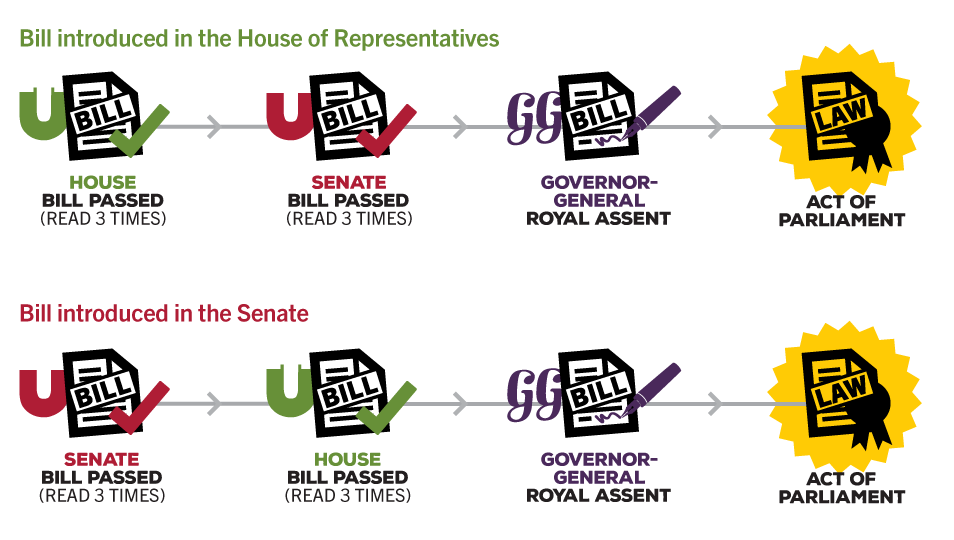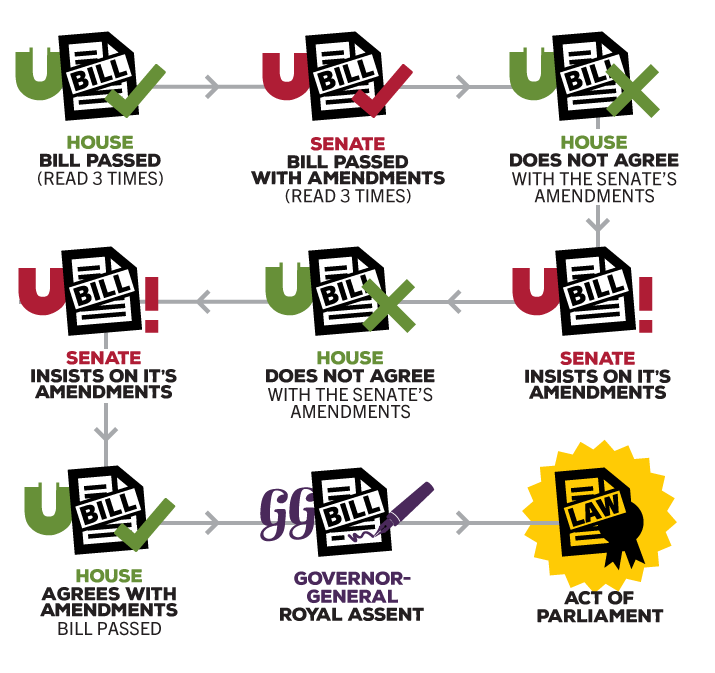
One of the main roles of the Australian Parliament is to make laws for the people of Australia. Scroll down to learn more about each step of the law-making process.

One of the main roles of the Australian Parliament is to make laws for the people of Australia. Scroll down to learn more about each step of the law-making process.
Scroll down
A bill is a proposal for a new law or a change to an existing one. A bill becomes a law if it is passed in identical form by both the House of Representatives and the Senate, and given Royal Assent by the Governor-General. It is then known as an Act of Parliament.
Most bills are introduced into the House of Representatives and then sent to the Senate. Bills may start in the Senate, except for money and taxation bills. Most bills are introduced by government ministers; however, other members of parliament can introduce their own bills, known as private members' or private senators' bills.
It may take months or even years for a bill to pass through Parliament. However, an urgent bill can be passed in a matter of hours or days. Well over 100 bills are introduced into Parliament each year and about 90 per cent of government bills are passed into law.
Most bills are drafted by public servants on behalf of a minister and formally approved by the government before they are introduced into the Parliament.
The original ideas for government legislation come from various sources. They may result from party policy, from suggestions by senators and members or from community groups, or those of a routine nature may originate in government departments.
Usually a Minister who wants to introduce a bill gives written notice (advance warning) of his or her intention to do so. Notice is typically given for the next sitting day.
In the House of Representatives the Minister lodges their written notice with the Clerk of the House who arranges for the bill to be listed on the Notice Paper (the House's agenda of business). Notice is not necessary for bills which appropriate money or bills dealing with taxation.

When the notice is reached during the following day's business, the Minister presents the bill, and the Clerk reads out its title. This is known as the first reading. In the House, the first reading is strictly a formality and no vote is taken. The bill is introduced to Parliament.
The Minister then moves that the bill 'be now read a second time' and makes a speech explaining the purpose, general principles and effect of the bill. This is known as the ‘second reading speech’. At the end of the speech, debate is usually adjourned to allow members time to study the bill and its effects before speaking and voting on it, and to provide the opportunity for public discussion and reaction. Urgent bills might be debated straight away.
All bills introduced into either House are examined by the Legislative Scrutiny Committees, which can ask the responsible minister for more information about a bill's impact on rights:
The Human Rights Committee examines all bills for compatibility with international human rights standards.
The Scrutiny of Bills Committee assesses the effect bills would have on individual rights, liberties and obligations.
The Selection of Bills Committee considers all bills (other than those that only appropriate revenue or money) and recommends whether they should be referred to one of the Senate's committees for further examination and feedback from constituents, interest groups and affected individuals.
If the Committee decides a bill needs further investigation, it will recommend to the Senate that it be
Committees provide a formal channel of communication between Parliament and the public and this encourages greater community participation in the parliamentary process. They allow for a greater variety of opinions to be placed on the public record to ensure that parliamentarians are well-informed before making decisions.
Submissions from individuals, subject matter experts, business and government provide the committee with a range of perspectives about the proposed policy changes to law. These views inform the committee’s recommendation in its report to the Senate.
Public hearings are another way for committees to seek information and to test claims made in submissions. Hearings are usually conducted in a question and answer format. Participation at hearings is by invitation from the committee. These hearings take place at Parliament House and around Australia. They can happen in person or by video- or teleconference.
From 1970 to 1990, the Senate referred only 55 bills to committees for consideration. The adoption
of new processes in 1990 saw a substantial increase in the number of referrals with an average
of 30% of bills now being referred each year.
A committee has no power to amend a bill, but may recommend that it be passed as is or with amemdments.
The second reading debate considers the principles of the bill and is normally the most substantial debate that takes place. The debate may take place in the Federation Chamber. Amendments may be moved at this stage, but they do not affect the text of the bill and are generally used to express an opinion about the bill or related policy issues. At the end of the debate, the House votes on the motion moved by the Minister - 'That this bill be now read a second time'. If the motion is agreed to (spoiler it always is), the Clerk reads the title again, signifying that the bill bas been agreed to in principle.
Any member may propose amendments to the text of a bill. Once the bill has been read a second time, the amendments will be debated during the consideration in detail stage.
The bill does not progress further, it is no longer before the Parliament and it does not become law.
The second meeting place for the House of Representatives. It operates at the same time as the House, which allows two items of business to be considered at the same time.
Just as all bills must be debated and voted on in the Parliament, amendments must also be debated and voted on. Amendments can be introduced in either House and must be agreed to by both.
Disagreement with a bill is often indicated by voting against the motion for the second or
third reading, which is taken to be a rejection of the bill.
It is rare for this to occur in the House of Representatives in relation to government bills.
The purpose of this stage is to consider the detail of the bill and to enable proposed changes (amendments). Proceedings are less formal than for the second reading debate and members may speak for 5 minute intervals an unlimited number of times on amendments put forward. If members agree that a particular bill does not need to be examined in detail, this stage may be by-passed.
This is the final stage of consideration of a bill and is usually a formality. The motion by the Minister - 'that this bill be now read a third time' - may be debated, but this is relatively rare. If the motion is agreed to, the Clerk reads the title again, which signifies that the bill has passed the House.


As well as delivering messages to the Senate, the Serjeant-at-Arms has several responsibilities
in the House of Representatives. These include assisting the Speaker to maintain order,
recording the attendance of members, and playing an important role in ceremonial occasions
such as the opening of Parliament.
When not in the House, the Serjeant has an administrative role within the Department of the
House of Representatives and is responsible for, among other things, office accommodation
and maintaining security in the House of Representatives wing of Parliament House.
The President announces receipt of the message. The Minister then moves that the bill be now read a first time and, if that motion is agreed to, the Clerk reads out its title - the first reading.
The Minister then moves that the bill be read a second time. At this stage, debate is usually adjourned. If a Senate committee is still inquiring into the bill, debate cannot continue until the report is presented to the Senate. Urgent bills might be debated straight away.
Information is compiled into a report, which may recommend amendments to the bill, and presented in the Senate. The bill is now available to be debated.
This debate represents the major policy debate on the bill. Amendments may be moved at this stage,
most commonly by Opposition or crossbench senators. These do not affect the text of the bill and are
generally used to express an opinion about the bill or related policy issues.
At the end of the second reading debate, the Senate votes on the motion moved by the Minister - 'That this bill be now read a second time'.
If that motion is agreed to, the Clerk reads out its title - the second reading.
Any senator may propose amendments to the text of a bill. Once the bill has been read a second time, the amendments will be debated during the committee of the whole stage.
The bill does not progress further, it is no longer before the Parliament and it does not become law.
Just as all bills must be debated and voted on in the Parliament, amendments must also be debated and voted on. Amendments can be introduced in either House and must be agreed to by both.
Disagreement with a bill is often indicated by voting against the motion for the second or third reading, which is taken to be a rejection of the bill. A senator may also move that a bill be discharged – or removed – from the Senate Notice Paper, which means that the bill will not proceed.
Debate in committee of the whole is a flexible and interactive process in which the details of the bill
are queried and amendments are moved, debated and determined. Senators may ask questions directly of the
minister and there are no restrictions on the number of times they may speak.
If there are no amendments
proposed to the bill, and no senator wishes to debate the details or ask questions, the committee of the whole stage may
be omitted.
Amendments moved in committee of the whole seek to change, delete or add words in the bill and affect the final content of the law.
The Senate cannot amend taxation bills or certain bills which appropriate money. It may only request that the House of Representatives amend such bills.
Amendments may be moved by any senator. Non-government amendments have a greater chance of success in the Senate where the government does not usually have a majority. Any amendments made by the Senate must, however, be agreed to by the House of Representatives.
Under section 53 of the Constitution the Senate cannot amend a bill imposing taxation, or a bill appropriating money for the ordinary annual services of government. It may also not amend a bill in a way which will increase any proposed charge or burden. If the Senate determines such amendments are required, it must request that the House of Representatives amend the bill on its behalf.
At the end of the committee of the whole stage, the bill is agreed to, either with or without amendments, and the committee reports back to the Senate. The Minister moves that the report of the committee be adopted by the Senate.
Once this is agreed to, the Minister moves that the bill be read a third time. The third reading is an opportunity for the Senate finally to consider the bill as it has emerged from committee of the whole. If the Senate agrees to this motion, the Clerk reads the bill title - the third reading. This signifies that the bill has passed the Senate.
If the Senate is dissatisfied with the bill as it has emerged from committee of the whole, a vote against the third reading is a rejection of the bill. The bill does not progress further, it is no longer before the Parliament and it does not become law.


As well as delivering messages to the House, the Usher of the Black Rod has several
responsibilities in the Senate. These include assisting the President to maintain order,
recording the attendance of senators, and playing an important role in ceremonial occasions
such as the opening of Parliament.
When not in the Senate, the Usher has an administrative role within the Department of the
Senate and is responsible for, among other things, office accommodation, maintaining security
in the Senate wing of Parliament House, finance and human resources for the department,
and printing and publishing Senate documents.
For the bill to progress further, the House of Representatives must consider the amendments and vote to decide if it agrees with them.
whether or not to insist on its amendments. If it insists, the House must decide whether to agree or insist on disagreeing. Ultimately, if agreement cannot be reached, the bill will be laid aside.

The Governor-General is appointed by the Queen to be Her Majesty's representative in Australia. They are appointed on the recommendation of the Prime Minister, usually for a term of 5 years. The Governor-General has some of the responsibility for ensuring that Australia is governed according to the rules set out in the Constitution.

Produced by the Department of the Senate
Further reading
Contact us
[email protected]
© Commonwealth of Australia
Bill is being examined by a Senate Committee

